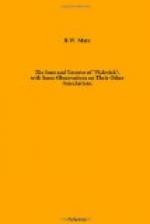The “George and Vulture”
Tucked away in the heart of the busiest part of the roaring city, overshadowed by tall, hard-looking, modern banking and insurance buildings and all but a thin strip of it hidden from view, is a veritable piece of old London.
This is the “George and Vulture,” known throughout the world as the tavern that Mr. Pickwick and his friends made their favourite city headquarters. The address in the directory of this inn is St. Michael’s Alley, Cornhill; The Pickwick Papers, however, describe it as being in George Yard, Lombard Street. Both are correct. If the latter address is followed, the inn is not easy to find, for the sign “Old Pickwickian Hostel” is so high up over the upper window in the far left-hand corner that it is almost the last thing one sees. One fares little better from the other approach, for the narrow alley with its tall buildings facing each other so closely as to be almost touched with outstretched arms, makes it necessary to search for the entrance doorway.
These, however, are not drawbacks to the lover of old London, for he rather prefers to probe about for things he likes, particularly when, as in this case, the discovery is worth the trouble; for once inside the “George and Vulture” the pilgrim will be thoroughly recompensed for the trouble he has taken in finding it. Here he will be struck by the atmosphere of old time which still prevails, even though there are signs that the modern has somewhat supplanted the old. Not long since the dining-room on the ground floor was well sawdusted, and partitioned off in the old coffee-room style, and some of these high-backed box-like compartments still remain in corners of the room. With the knowledge that this ancient hostelry was called “Thomas’s Chop House”—and it still bears that name ground on the glass doors—one expects to discover a grill loaded up with fizzing chops and steaks, and there it will be found, presided over by the white-garbed chef turning over the red-hot morsels.
Opposite the door is the old-fashioned bar, with a broad staircase winding up by its side to another dining-room above completely partitioned off into compartments with still another grill and a spotlessly robed chef in evidence. Up another flight of stairs we come to yet one more dining-room recently decorated in the old style, with oak-beamed ceiling and surroundings to match; with lantern lights suspended from the oak beams, grandfather clock, warming pan, pewter plates and odd pieces of furniture in keeping with the period it all seeks to recall. It is called the “Pickwick Room,” and this metamorphosis was carried out by a city business firm for the accommodation of its staff at lunch, and its good friendship toward them admirably reflects the Dickens spirit. Here the members of the general staff, both ladies and gentlemen, numbering about 170, daily gather for their mid-day meal; whilst a small cosy room adjoining is et apart for the managerial heads. On occasions, representatives of associated houses in the city and from abroad, calling on business, are cordially invited to join the luncheon party.




